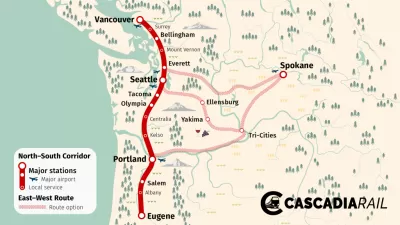The state of Washington is hoping federal infrastructure funding can pay for $198 million of the $348 million necessary to plan the Cascadia High-Speed Rail project.

Legislators in the state of Washington are applying for $198 million in federal funding from the Infrastructure Investment and Jobs act to fund planning work for a proposed 290-mile high-speed rail route connecting Portland, Oregon to Vancouver, British Columbia, with stops along the way including Seattle, Tacoma, Olympia, and more.
Mike Lindblom reports that Washington State legislators sent a letter to U.S. Transportation Secretary Pete Buttigieg making the case for the funding.
Plans call for an electric-powered system that would reach top speeds of 250 miles per hour, according to Lindblom. “The Cascadia high-speed corridor would be faster than any trains that currently operate in the United States, though contractors are now building a starter bullet-train line in central California,” according to Lindblom.
The project is still in relatively nascent stages. “So far, proponents haven’t clearly explained where to place dedicated tracks so they’re apart from other trains, motor vehicles and people, allowing 250 mph travel. That’s what a $348 million planning investment is for,” explains Lindblom.
A report on the project, submitted to the Washington State Legislature in June 2023, estimates the total cost of the project at $42 billion in 2017 dollars. However, an independent legislative review also published in June adjusted the estimate to $63 billion in 2023 dollars, based on construction inflation.
FULL STORY: WA Democrats ask Buttigieg for $200M to plan Canada-Seattle-Portland bullet train

Manufactured Crisis: Losing the Nation’s Largest Source of Unsubsidized Affordable Housing
Manufactured housing communities have long been an affordable housing option for millions of people living in the U.S., but that affordability is disappearing rapidly. How did we get here?

Americans May Be Stuck — But Why?
Americans are moving a lot less than they once did, and that is a problem. While Yoni Applebaum, in his highly-publicized article Stuck, gets the reasons badly wrong, it's still important to ask: why are we moving so much less than before?

Using Old Oil and Gas Wells for Green Energy Storage
Penn State researchers have found that repurposing abandoned oil and gas wells for geothermal-assisted compressed-air energy storage can boost efficiency, reduce environmental risks, and support clean energy and job transitions.

Updating LA’s Tree Rules Could Bring More Shade to Underserved Neighborhoods
A new USC study finds that relaxing Los Angeles’ outdated tree planting guidelines could significantly expand urban tree canopy and reduce shade disparities in lower-income neighborhoods, though infrastructure investments are also needed.

California's Canal Solar Projects Aim to Conserve Resources and Expand Clean Energy
California’s Project Nexus has begun generating electricity from solar panels installed over irrigation canals, with researchers and state agencies exploring statewide expansion to conserve water and boost clean energy production.

HHS Staff Cuts Gut Energy Assistance Program
The full staff of a federal program that distributes heating and cooling assistance for low-income families was laid off, jeopardizing the program’s operations.
Urban Design for Planners 1: Software Tools
This six-course series explores essential urban design concepts using open source software and equips planners with the tools they need to participate fully in the urban design process.
Planning for Universal Design
Learn the tools for implementing Universal Design in planning regulations.
Heyer Gruel & Associates PA
City of Moreno Valley
Institute for Housing and Urban Development Studies (IHS)
City of Grandview
Harvard GSD Executive Education
Salt Lake City
NYU Wagner Graduate School of Public Service
City of Cambridge, Maryland




























